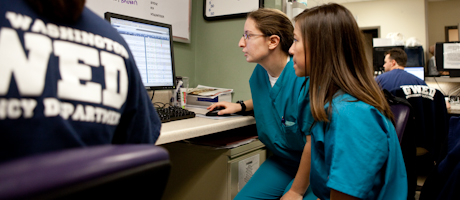By Jennifer Price
Emily Martuscello dreams of saving lives as an emergency medicine physician.
But because she’s only a freshman at George Washington, it will be several years before she’s called Dr. Martuscello.
That’s why she decided to take a class in emergency department critical care assessment and procedures this semester so that she can have hands-on experience long before she gets to wear a white coat.
While the first half of the course is spent in the classroom and in GW’s simulations center, the second half is spent in the George Washington University Hospital’s Emergency Room.
“You really learn the ins and outs of the hospital, and you feel like you’re actually applying what you’ve learned,” says Ms. Martuscello, a student in GW's School of Media and Public Affairs. “For me to be a freshman and already be working on patients, which I didn’t think I would be doing until I was in medical school, is pretty amazing.”
Students learn how to care for wounds, administer EKGs, insert IVs, draw blood and splint broken bones. Before beginning their 60 required clinical hours, they practice in the hospital’s simulations center.
The class is taught by doctors Ali Pourmand and Ryanne Mayersak, both of whom are assistant professors of emergency medicine. The class is also taught by Dr. Robert Shesser, chair of the department of emergency medicine and professor of emergency medicine.
After completing the class, students are qualified to work as emergency department technicians at any hospital.
“This class is a prime example of how GW students are learning hands-on and how GW prepares students for the workforce,” says Ms. Martuscello.
Ms. Martuscello had her first eight-hour clinical shift last week where she shadowed and assisted an emergency department technician by inserting an IV into a few patients, taking several EKGs on patients who complained of chest pain and transporting patients for X-rays.
“Being in the hospital, you learn the little things you would never learn in the classroom,” she says. “And getting to work at a Level 1 trauma center in the middle of Washington, you get to see a wide range of things.”
The best part about the class is being able to interact with patients, says Jessica Watari, a sophomore in the Columbian College of Arts and Sciences.
“Making patients happy because you did the little things for them is so rewarding,” she says.
Both Ms. Martuscello and Ms. Watari are enjoying the class so much that they plan to apply to be an emergency department technician at a hospital this summer.
The students also think the class will give them an advantage when applying to medical school because of the clinical experience and patient interaction.
“When applying to medical school, you have to have something that makes you stand out among the rest,” says Ms. Martuscello.
The class also provides an opportunity for students to make sure that medicine is the right career for them, says Ms. Watari.
“Some people get to medical school and figure out that patient care and medicine is not the best choice for them, but this class is an experience that really tells you whether or not you can handle it,” she says.


